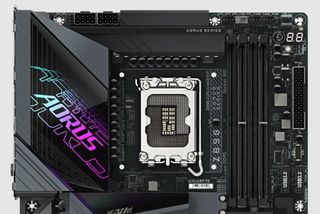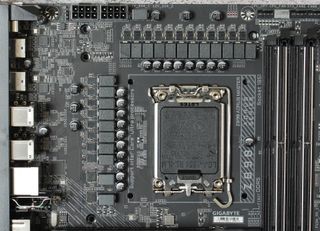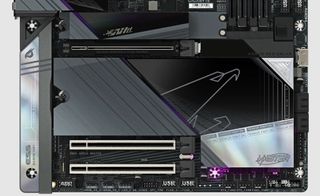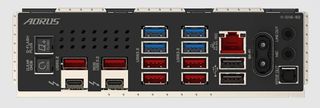Gigabyte Z890 Aorus Grasp Motherboard Evaluation: ATX with 14 USB ports, extraordinarily fast memory assist
Beneath, we’ll have a look at the small print of the Z890 Aorus Grasp and resolve whether or not or not it deserves a spot on our Biggest Motherboards guidelines. Nonetheless sooner than we share check out outcomes and dig deep into the board’s choices, beneath are the specs from the Gigabyte site.
Gigabyte’s Z890 Aorus Grasp is a premium motherboard that helps Intel’s new Arrow Lake processors. The board moreover receives a facelift, an additional PCIe 5.0 x4-capable M.2 socket (now two), Thunderbolt 4 (40 Gbps) Form-C ports, further ‘EZ’ choices, and AI overclocking. Priced at $599.99, the MSRP did go up from the Z790 mid-lifecycle exchange Aorus Grasp X ($550), nonetheless it stands up successfully to the direct rivals.
Gigabyte has quite a lot of Z890-based SKUs throughout the product stack—the reality is, the company has basically essentially the most, at 18. We gained’t guidelines all of them proper right here, nevertheless you’ll see all the acquainted faces and additional. This consists of Micro ATX and Mini-ITX boards and prices ranging from $179.99 (Z890M Gaming X) to the Z890 Aorus Extreme ($999.99+?). As well as they’ve quite a lot of white variations of some boards, which worth the similar as their darker counterparts. We could be shocked within the occasion you’ll be able to’t uncover a motherboard that works for you with all the obtainable decisions from Gigabyte.
Testing on the Z890 Aorus Grasp went successfully. Even with settings very similar to these of various boards, the Aorus Grasp sipped on the power comparatively, with effectivity varied counting on the exams. Gaming effectivity was secure in our two titles, whereas the other benchmarks sometimes blended in with the other Z890 information we’ve gathered thus far.
Specs of the Gigabyte Z890 Aorus Grasp
| Socket | Intel (LGA 1851) |
| Chipset | Z890 |
| Form Subject | ATX |
| Voltage Regulator | 21 Part (18x 110A SPS MOSFETs for Vcore) |
| Video Ports | (2) Thunderbolt 4 (Form-C) |
| Row 5 – Cell 0 | (1) HDMI (v2.1) – Entrance |
| USB Ports | (2) Thunderbolt4 (40 Gbps) Form-C |
| Row 7 – Cell 0 | (6) USB 3.2 Gen 2 (10 Gbps) |
| Row 8 – Cell 0 | (4) USB 3.2 Gen 1 (5 Gbps) |
| Row 9 – Cell 0 | (2) USB 2.0 (480 Mbps) |
| Neighborhood Jacks | (1) 10 GbE |
| Audio Jacks | (2) Analog + SPDIF |
| Legacy Ports/Jacks | ✗ |
| Completely different Ports/Jack | ✗ |
| PCIe x16 | (1) v5.0 (x16/x8) |
| PCIe x8 | ✗ |
| PCIe x4 | ✗ |
| PCIe x1 | ✗ |
| DIMM Slots | (4) DDR5-9500+(OC), 256GB Functionality |
| M.2 Sockets | (2) PCIe 5.0 x4 (128 Gbps) / PCIe (as a lot as 110mm) |
| Row 20 – Cell 0 | (1) PCIe 4.0 x4 (64 Gbps) / PCIe (as a lot as 110mm) |
| Row 21 – Cell 0 | (1) PCIe 4.0 x4 (64 Gbps) / PCIe (as a lot as 80mm) |
| Row 22 – Cell 0 | (1) PCIe 4.0 x4 (64 Gbps) / PCIe/SATA (as a lot as 80mm) |
| Row 23 – Cell 0 | (Helps RAID 0/1/5/10) |
| SATA Ports | (4) SATA3 6 Gbps |
| Row 25 – Cell 0 | (Helps RAID 0/1/5/10) |
| USB Headers | (1) USB v3.2 Gen 2×2 (20 Gbps) Form-C |
| Row 27 – Cell 0 | (2) USB v3.2 Gen 1 (5 Gbps) |
| Row 28 – Cell 0 | (2) USB v2.0 (480 Mbps) |
| Fan/Pump Headers | (10) 4-Pin (CPU, System followers) |
| RGB Headers | (4) aRGB Gen 2 (3-pin) |
| Row 31 – Cell 0 | (1) RGB (4-pin) |
| Diagnostics Panel | EZ Debug Zone |
| Row 33 – Cell 0 | (1) Debug Port (2-character) |
| Row 34 – Cell 0 | (1) Debug LEDs |
| Internal Button/Change | (1) Vitality button |
| Row 36 – Cell 0 | (1) Reset button |
| SATA Controllers | ✗ |
| Ethernet Controller(s) | (1) Marvell AQC113C (10 GbE) |
| Wi-Fi / Bluetooth | Intel Wi-Fi 7 BE200NGW (2×2- 320 MHz, 6 GHz, BT 5.4) |
| USB Controllers | Realtek RTS5411S, RTS54361, RTS5464 |
| HD Audio Codec | Realtek ALC1220 w/ESS Sabre9118 DAC |
| DDL/DTS | ✗ / DTS:X Extraordinarily |
| Assure | 3 Years |
Contained within the Discipline of the Gigabyte Z890 Aorus Grasp
Gigabyte includes a handful of apparatus contained within the discipline to help ship a optimistic setting up experience. You get the usual assortment of SATA cables, a quick-connect Wi-Fi antenna, and some totally different useful objects, along with the DDR Wind Blade to relax off your high-speed RAM. Beneath is an entire guidelines of the extras.
- Wi-Fi Antenna (w/EZ-plug)
- (2) Thermistors cables
- (2) SATA cables
- G-Connector
- Microphone
- DDR Wind Blade (RAM fan)
- Arrange info
- Stickers
Design of the Z890 Grasp
The Aorus Grasp has always been a good-looking motherboard, which does not change with Z890. We nonetheless see large, outsized heatsinks with the Aorus branding on prime, illuminated by RGB LEDs. The underside of the board makes use of an enormous plate-style heatsink with a brushed finish and some reflective chrome highlights on the chipset heatsink with the Grasp branding and Aorus motto of “Crew up, Battle On” emblazoned on these shiny parts. For the first PCIe 5.0 M.2 socket makes use of a lots greater specific individual heatsink whereas the rest use a straightforward plate heatsink, and all using EZ clips to remove. The Aorus falcon flexes proudly between the PCIe slots whereas one different RGB strip lights up the underside part of the board. In the long run, we like what we see, and the updated aesthetic blends in with most assemble themes.

The first merchandise we encounter on the very best left is the two (one required) 8-pin EPS connectors to power the processor. Subsequent to them is the first 4-pin fan header, with the other 9 (certain, 9!) above the RAM slots and alongside the underside edge. Each header helps PWM and DC-controlled devices, with power output all of the similar at 2A/24W. The ten entire fan headers are basically essentially the most I’ve seen on a consumer board, and there could also be a great deal of power to go spherical. Administration over these headers is managed by the use of the BIOS or Gigabyte Administration Coronary heart’s (GCC) Fan Administration software program.
Subsequent, we run into the 4 RAM slots with locking mechanisms on both facet to protected your memory package deal. Gigabyte offers assist for as a lot as 256GB and speeds as a lot as DDR5-9500(OC), considered one of many quickest we’ve come all through for the platform. We had no factors working the quickest kits in-house (DDR5-8200) with out problem and, as a minimum on paper, there’s a great deal of headroom left. Above that are 4 further fan headers, and immediately to the suitable are the first (of two) 2-pin headers for thermistors.
Within the applicable nook, we see the first two (of 4) 3-pin ARGB headers, with the other two located alongside the underside edge. There’s moreover a 4-pin RGB header on the bottom, too. Administration over the built-in and linked RGBs comes from GCC and the RGB Fusion app. There are a selection of canned LED outcomes, numerous which you will tweak the speeds and hues to your liking, or just shut all of them off when it is worthwhile to.
Transferring down the suitable edge, we run into the two-character Debug port and the four-LED POST debugger, which helps to find out any factors that come up all through POST. Merely to the left are useful power and reset buttons. Subsequent, we uncover the 24-pin ATX connector to power the board, a front-panel USB 3.2 Gen 2×2 (20 Gbps) Form-C header, and two 19-pin front-panel USB 3.2 Gen 1 (5 Gbps) ports. If the 14 USB ports on the rear IO come what may aren’t ample, there are tons for the doorway panel as successfully.

The Z890 Aorus Grasp’s VRM consists of 21 phases, 18 for Vcore, that may merely take care of any processor you positioned on it. Astute readers may acknowledge that’s fewer than the ultimate period, nevertheless these processors are moreover further atmosphere pleasant. Vitality comes from the dual 8-pin EPS connectors, then onto the acquainted Renesas RAA229130 PWM controller. From there, we ran into the 18 Renesas R2209004 SPS MOSFETs rated at 110A each in a ‘twin’ configuration. As soon as extra, there could also be a great deal of power, even when overclocking the flagship half like our Core 9 Extraordinarily 285K. CPU temperatures will limit you sooner than the power provide does.

On the underside half of the board, hiding beneath the metallic shroud, is a high-quality audio decision using the Realtek ALC1220 codec and an ESS SABRE9118 DAC. It’s a flagship-class audio decision that almost all prospects must be glad with. Though that is possible one of many greater audio choices, we wish to see the latest codec like its mates use.
Throughout the middle are three full-length PCIe slots, all using some sort of reinforcement. The very best slot sports activities actions Gigabyte’s UD Slot X reinforcement and a PCIe EZ Latch button to remove the cardboard merely. The very best connects by the use of the CPU and is the one actual PCIe 5.0 x16 slot. Using a lesser UD Slot reinforcement (bear in mind that’s non-X), the underside two slots be a part of by the use of the chipset and run as a lot as PCIe 4.0 x4 and x1 (middle and bottom) speeds. There’s some lane sharing. When M2D_CPU (the second 5.0 x4-capable M.2 socket) is populated, the very best/CPU-connected slot drops to x8 speeds. Exterior of that, it’s clear crusing.
5 M.2 sockets cowl beneath the heatsinks on the underside of the board, each using the M.2 EZ Latch to protected your system with out these tiny screws. You get two PCIe 5.0 x4 (128 Gbps) sockets and three PCIe 4.0 x4 (64 Gbps) sockets. Must you private or plan to buy a SATA-based M.2 module, you’re in luck, as considered one of many sockets, M2M_SB, helps PCIe and SATA devices. In case your use case requires redundancy or further storage velocity, the Aorus Grasp helps RAID0/1/5/10 modes on the NVMe drives.
Earlier the chipset, alongside the suitable edge, we see an HDMI port that will monitor the system with the Sensor Panel software program (monitor required). Beneath are 4 SATA ports (helps RAID0/1/5/10) and two further 4-pin fan headers.
All through the underside of the board are quite a lot of uncovered headers. You’ll uncover the usual stuff proper right here, along with further USB ports, RGB headers, and so forth. Beneath is an entire guidelines, from left to correct.
- Entrance panel audio
- (2) 4-pin RGB headers
- 3-pin RGB header
- DB sense
- TPM header
- (2) USB 2.0 headers
- (3) System fan headers
- 2-pin temperature sensor header
- Clear CMOS jumper
- Reset jumper
- Entrance panel

Certainly one of many first stuff you’llnotice on the rear IO is that it’s stuffed with USB ports – 14 in entire. You get the two Thunderbolt 4 (40 Gbps) ports that moreover double as video outputs, six USB 3.2 Gen 2 (20 Gbps, all Form-A) ports, 4 USB 3.2 Gen 1 (5 Gbps) ports, and two USB 2.0 ports. On the left are the Clear CMOS and Q-Flash Plus buttons to reset the BIOS or exchange it (even with out a CPU).
On the suitable are the Marvell 10 GbE port, the quick-connect Wi-Fi 7 antenna headers, and a main audio stack with line out, microphone, and SPDIF optical output. Exterior of the sheer number of USB ports and some venting for the VRMs, there’s nothing out of the peculiar proper right here.
MORE: Biggest Motherboards
MORE: How To Choose A Motherboard
MORE: All Motherboard Content material materials







